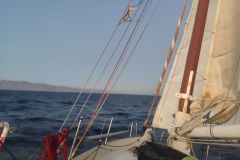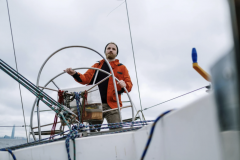Single-handed sailing attracts many sea enthusiasts, offering total freedom and a unique connection with the ocean. However, it also requires a careful choice of sailboat, which must be easy to handle, safe and adapted to the sailor's needs. Between boat size, comfort and budget, several criteria need to be taken into account for a successful experience.
Choosing a sailboat for single-handed cruising requires careful consideration of a number of criteria. The ideal size is often between 30 and 40 feet, offering a good compromise between ease of navigation and comfort of life on board. Handling and safety are essential aspects to consider, as is equipment to ensure smooth, trouble-free sailing. By taking these factors into account, every sailor will be able to find the right yacht for his or her project, whether it involves long cruises or more sporty outings.

What is the ideal size for a single-handed sailboat?
The choice of sailboat size depends mainly on the ease of manoeuvring and the level of comfort required. A boat that is too big can be difficult to manage alone, while one that is too small may lack essential equipment. For short cruises or regattas, a sailboat under 10 meters is often sufficient. The First 210, for example, is a 6.50-meter sailboat that allows you to sail far and safely, while remaining easy to handle. But it may lack the electrical power (battery capacity) to support the discharge of an autopilot, for example.
For those seeking a compromise between comfort and performance, a 9 to 12-meter sailboat is an ideal solution. Models like the RM 890+ offer good habitability without compromising maneuverability. On the other hand, if you're aiming for a long, single-handed cruise, a yacht longer than 12 meters is more suitable. It allows you to carry more provisions and equipment, offering greater autonomy at sea.
Easy manoeuvring and essential equipment
A sailboat designed for single-handed sailing must be easy and efficient to maneuver. The presence of an autopilot is essential to maintain a steady course, especially on long crossings. Self-tailing winches make sail trimming easy, while a furling genoa and automatic reefing allow you to quickly adapt the sails to weather conditions. The mooring system should also be optimized, with an electric windlass and easily accessible anchor to simplify mooring maneuvers.

Striking the right balance between comfort and performance
The choice of sailboat also depends on its intended use. For leisure sailing and long crossings, comfort is a decisive criterion. A sailboat with a spacious cabin, a well-appointed saloon and sufficient storage space will enable you to live aboard for several days, or even weeks, in good conditions. Conversely, for sport sailing or regattas, it's preferable to opt for a light, responsive yacht, such as a JPK or Ofcet 32, which maximize speed and sensations at sea.
What's the maintenance budget?
Buying a sailboat is only part of the budget. You also need to anticipate the recurring costs of maintenance and storage. The price of a sailboat varies according to its size and equipment, but annual maintenance represents on average 10% of the purchase price. To this must be added the cost of storage in harbor or anchorage, as well as any repairs required depending on sailing conditions and wear and tear.

Solo, safety first
Sailing alone requires rigorous preparation and full safety equipment. A VHF radio allows you to communicate with other vessels and rescue services in the event of a problem. A personal locator beacon (PLB) is essential, to be carried with you to signal your position in case of emergency. A liferaft and self-inflating lifejackets must be available and in perfect working order. In addition, an AIS system improves the visibility of the yacht to avoid collisions with other craft. Finally, good boat maintenance and specific training in solo sailing are strongly recommended to minimize risks.

 /
/ 







